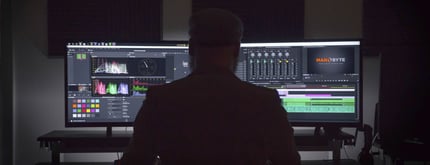
In today's day and age, we have come a long way from those massive camcorders and bulky splicing equipment to edit scenes. Because of cell phones, it's now easier than ever for enthusiasts to shoot high-quality videos in high-definition. But aside from the basic mobile phone editing applications, what are the best software options available today for editing video?
All the video editing softwares listed include splitting, joining, and trimming video clips. They all have capabilities to do Picture in Picture (PIP), green screening (chroma-keying), animated transitions and more. They are all Non-Linear Editing Systems (NLE).

Adobe Premiere CC
Adobe Premiere of the Creative Cloud, as of June 2016, has one of the most collaborative workflows of all editors. Adobe Premiere draws advantages from its seamless integration with Adobe’s After Effects, PhotoShop, and the Creative Cloud. Adobe Premiere supports 4K, 360-degree content, and multi-cam editing. Users can take advantage of proxy media creation, virtual reality editing, multi-sessions for field dominance, purchasable stock assets, manipulating closed captions, a scriptwriting tool, and much more. You can see the details you need right in the Source and Program Monitor panels, and you can switch between video and audio waveforms with just one click. Enhanced Lumetri Color tools provides new ways to get creative with color, and Dynamic Link eliminates intermediate rendering between Premiere Pro and Adobe After Effects/Adobe Audition for a seamless workflow. Adobe Premiere has been and will likely remain a leading industry powerhouse for video editing. Keep in mind, however, that these are only available with an Adobe Subscription.
In recent years, Adobe Premiere Pro has dominated the NLE market. Its subscription-based service and prolific development team makes it an excellent fit for many editors.

Final Cut Pro X
Apple's professional-level video editing software, Final Cut Pro X, brings a ton of power in a simple interface to both video professionals and consumers alike. Final Cut Pro also comes with stunning 3D titling capabilities. The software comes quipped with a multi-camera capability, a denoiser for optimal audio, as well as multi-channel audio editing. Additionally, the Magnetic Timeline improves traditional ways of trimming, including ripple, roll, slip, and slide edits. Final Cut Pro X comes with the ability to use alt text, keywords, and smart collections in order to make for a clean and organized workflow. Native format support, unified imports, and all of Final Cut’s great features are what allow the Apple Video Editing Software to compete with others like Avid and Adobe. Final Cut Pro X is only available on Apple’s OS and can be purchased for $299.99 in the App Store.
Of all the NLE’s listed, Final Cut Pro X is known for being the easiest editing system to learn how to use, and will be the most comfortable for someone who is used to working on Apple systems.
Blackmagic’s DaVinci Resolve 12.5
DaVinci resolve combines professional nonlinear video editing with the world’s most advanced color corrector, so now you can edit, color correct, finish and deliver all from one system. It comes complete with the following key features:
- Natural 32 bit float YRGB processing
- Power windows, tracking, primaries and secondary corrections
- Log, HSL and curve grading
- RGB mixing
- 3D object tracker and stereoscopic eye matching
- XML and AAF round tripping for NLE systems
- Optical quality resizing, noise reduction, and audio sync
DaVinci Resolve used to come with a hefty pricetag, nearing $40,000 for the system. However, Blackmagic Design acquired the company in 2009, and now DaVinci Resolve has a different advantageous market position. Black Magic DaVinci Resolve is loaded with effects and supports 4K, 360-degree content, and multi-cam editing. DaVinci Resolve even lets an editor and multiple colorists at different workstations share the same timeline and work together as they complete shots. BMDR 12.5 comes in a free version, a Studio version, and an Advanced control surfaces package.
While the price is right, Davinci Resolve remains complex to learn and lacks some of the more advanced tools one can find on other systems.
Avid
Most known for their Digital Audio Workstation Pro Tools, Avid’s video editing software is an industry standard as well. Known as their media composer, Avid provides native support for 2K, 4K, Ultra HD, and 8K media - making it easy to acquire, manage, edit, and deliver content quickly and simply. Equipped with full-featured 3D tools and workflows, the plug-ins for Media Composer include iZotope Insight Audio Metering, NewBlue Titler Pro v2, and Sorenson Squeeze Transcoding Software. To gain all features one must have a Floating Licenses Server. The full package costs between $200 to $50,000 so it’s normally a software to take advantage of if you have the capital and infrastructure in place, to begin with. Avid for years has helped to set the industry standard.
Avid is the gold standard for NLE systems. It’s both fast and powerful but the high price and steep learning curve make it inaccessible to many editors.
These tools are only as good as the individual or production team using them. Learning an editing software can be done as an individual, but in a forever growing competitive industry, gaining knowledge from universities and seminars can be helpful factors that propel one's video editing capabilities to new heights.
If you’re interested in professionally-made and edited video at a fair price, consider our Video Workshop on November 3rd. Click below to learn all about it.

